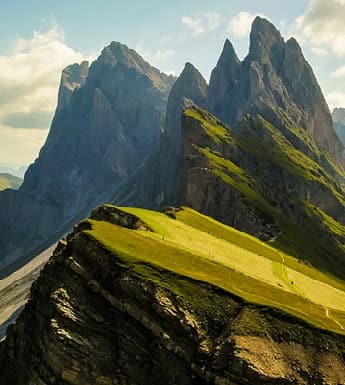The two major mountain ranges located in Italy are the Alps and the Apennines. Below we list facts about the Italian Alps followed by facts about the Apennines Mountain range.
Facts about the Italian Alps
- The Alps are a long mountain range spanning approximately 750 miles (1,200 kilometers). Besides Italy it stretches across France, Switzerland, Monaco, Liechtenstein, Austria, Slovenia, and Germany.
- The Alps formed millions of years ago by the African and Eurasian tectonic plates colliding and slowly over millions of years thrusting rock upward.
- The Italian Alps are classified into three main sections; the Western Alps, Central Alps, and Eastern Alps. Each of these sections is further divided into smaller subsections. For example, the Dolomites are subsection of the Eastern Alps.
- With a peak 15,780 feet (4,810 meters) above sea level, Mont Blanc (Monte Bianco) in the Alps is the highest mountain in Italy and the highest found in the Alps mountain range.
- The Italian Alps offers visitors great skiing, hiking, and natural beauty. One popular winter sports area is the Via Lattea (Milky Way) which is in the Alps along the French-Italian border.
- In 218 BC, during the Second Punic War, the Carthaginian general Hannibal, considered one of the greatest military leaders of all time, led his army over the treacherous Italian Alps and attacked the surprised Roman army. This was an incredible feat especially when you consider it involved thousands of soldiers and tons of equipment and supplies.
Facts about the Apennines Mountain Range
- The Apennines stretch 839 miles (1,350 kilometers) north to south covering the entire length of Italy.
- The Apennines extend from Northwestern Italy, where they connect with the Alps at Cadibona Pass all the way to the Strait of Messina in southern Italy.
- This mountain range can be viewed as having three separate parallel sections; northern, central and southern.
- Corno Grande, located in central Italy, is the tallest mountain in the Apennines. Its peak is 9,554 feet (2,912 meters) above sea level.
- This mountain range was formed by the collision of the African and the Eurasian tectonic plates. The collision of these two huge tectonic plates thrust rocks and soil upward.
- The mountains in Sicily are considered a continuation of this mountain range.
- Two active volcanoes, Vesuvius and Etna, are in the Apennines Mountain range.
- The Apennines are a great place to visit for those who love skiing, hiking, and just enjoying beautiful scenery. One popular place to visit is Monti Sibillini National Park which is known for its beautiful landscape and abundance of wildlife.
